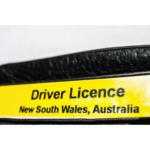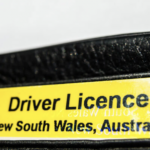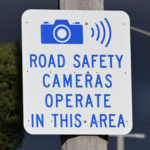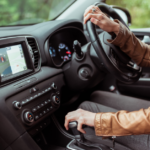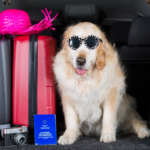Traffic Offences Relating to Not Wearing a Seatbelt in New South Wales
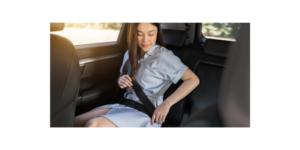
At the end of 2023, the New South Wales Government announced that existing mobile and fixed speed cameras across the state would soon be able to detect whether drivers and passengers are wearing seatbelts and increasing enforcement measures for the offence of not wearing a seat belt.
Parliament passed enabling legislation in October 2023 which will come into effect around the middle of this year.
The Government says there will initially be a grace period, allowing drivers to get used to the idea of being snapped for seat belt offences, issuing them with warning letters for a period of time rather than imposing fines.
Seatbelts save lives
Failing to wear a seatbelt can certainly increase the likelihood of major injury or even death following a collision.
This was the reasoning behind the introduction in 1971 of the rule requiring all drivers, passengers and their furry friends on New South Wales roads to wear seatbelts or approved restraints, enforceable through penalty notices for failure to comply.
According to Transport for New South Wales, an average of 29 drivers and passengers who are not wearing seatbelts are killed each year on the state’s roads and 79 are seriously injured.
The Government body says that wearing a seatbelt doubles the chance of surviving a collision and significantly reduces the risk of serious injury by:
- enabling deceleration at the same rate as a vehicle in the event of a collision,
- spreading the force of the impact over the pelvis and chest, which are stronger parts of the body,
- preventing impact with the interior of the vehicle,
- reducing risk of being thrown out of the vehicle, and
- working together with airbags to further reduce forward bodily movement, including whiplash.
The rules relating to wearing seatbelts in New South Wales
Regulation 264 of the Road Rules 2014 relates to the wearing of seatbelts by drivers of motor vehicles (not including motorcycles), and provides as follows:
- The driver of a motor vehicle that is moving, or is stationary but not parked:
(a) must occupy a driver’s seating position that is fitted with an approved seatbelt, and
(b) must not occupy the same seating position as another passenger, whether or not the other passenger is exempt from wearing a seatbelt under rule 267, and
(c) must wear the seatbelt properly adjusted and fastened, unless the driver is reversing the vehicle or exempt from wearing a seatbelt under rule 267.
So in a nutshell, a driver must wear a properly fasted seatbelt unless reversing or exempted by the road rules.
Exemption provisions
The exemption provisions in Regulation 267 provide as follows:
Authorisation by Transport for NSW
- A person is exempt from wearing a seatbelt if:
(a) the person is authorised by Transport for NSW under rule 268- 1 not to comply with rule 268 and is complying with the conditions (if any) of the authorisation, and
(b) the person is a passenger in or on a motor vehicle with 2 or more rows of seats and there is not another law of this jurisdiction permitting the person to sit in the front row of seats, and the person is not in the front row of seats.
Person over 7 where no requirement for belt to be fitted and belt not fitted
(1A) A person in or on a motor vehicle is exempt from wearing a seatbelt if:
(a) the seating position that he or she occupies is not fitted with a seatbelt, and
(b) there is no requirement for that seating position to be fitted with a seatbelt, and
(c) all passengers in the vehicle who are exempt from wearing a seatbelt are complying with subrule (8).
(1B) Subrule (1A) does not apply to a person who is under 7 years old.
Door-to-door deliveries / collections and garbage / waste collectors travelling under 25km/h
(2) A person in or on a motor vehicle is exempt from wearing a seatbelt if:
(a) the person is engaged in the door-to-door delivery or collection of goods, or in the collection of waste or garbage, and is required to get in or out of the vehicle, or on or off the vehicle, at frequent intervals, and
(b) the vehicle is not travelling over 25 kilometres per hour.
(2A) Subrule (2) does not apply to a person who is under 7 years old.
Certificate other than a medical certificate
(3) A person is exempt from wearing a seatbelt if–
(a) the person (or, for a passenger, the driver of the vehicle in or on which the person is a passenger) is carrying a certificate (other than a medical certificate issued under subrule (3A)), issued under another law of this jurisdiction, stating that the person is not required to wear a seatbelt, and
(b) the person is complying with the conditions (if any) stated in the certificate.
Subsection 4 requires the immediate production of the certificate.
Medical certificate
(3A) A person who is in, or on, a motor vehicle is exempt from wearing a seatbelt if–
(a) the person (or, if the person is a passenger in or on a vehicle, the vehicle’s driver) is carrying a medical certificate that states a medical practitioner believes the person should not wear a seatbelt because of a medical condition or disability the person has, and
(b) the person is complying with any conditions stated in the medical certificate, and
(c) no other law of this jurisdiction states that this subrule does not apply.
Subsection 4 requires the immediate production of the certificate.
Passenger in rear of police or emergency vehicle
(5) A person is exempt from wearing a seatbelt if:
(a) the person is a passenger in or on a police or emergency vehicle, and
(b) either:
(i) if the vehicle has 2 or more rows of seats–the person is not in the front row of seats or there is not a seating position available for the person in another row of seats, or
(ii) if the vehicle is a police vehicle and has a caged, or other secured, area designed for the carriage of passengers–the person occupies a seating position in that area.
Person receiving medical treatment
(6) A person is exempt from wearing a seatbelt if he or she is providing or receiving medical treatment of an urgent and necessary nature while in or on a vehicle.
(6-1) A person who is a passenger in a bus (within the meaning of the Passenger Transport Act 2014 ) is exempt from wearing a seatbelt (and from any requirement to use a seating position that is fitted with a seatbelt) if–
(a) the bus is being used to provide a public passenger service (within the meaning of that Act, and
(b) the bus is specifically designed for use by standing passengers, and
(c) in the case where the bus has one or more seating positions that are fitted with seatbelts–all of those seating positions are occupied by other passengers.
Sleeper compartment of bus or truck where there is a two-up driver
(7) If a truck or bus has a sleeper compartment, a two-up driver of the truck or bus is exempt from wearing a seatbelt while he or she occupies the sleeper compartment for rest purposes.
“Two-up driver” means a person accompanying a driver of a truck or bus on a journey, or part of a journey, who has been, is or will be sharing the task of driving the truck or bus during the journey.
subrule (8) to an approved child restraint includes a reference to an approved booster seat.
Main exemptions in summary
So the main exemptions are, in a nutshell:
- Drivers with a full (unrestricted) licence do not have to wear a seatbelt when they are reversing their vehicle or driving a garbage or delivery vehicle travelling below 25km/h and need to get in and out regularly.
- Passengers travelling with a driver with a full licence do not have to wear a seatbelt if they are administering or receiving urgent and necessary medical treatment
- Travelling in a garbage or delivery vehicle travelling below 25km/h and need to get in and out regularly.
- Drivers and passengers may be exempt from wearing a seatbelt if they have a medical condition and are carrying an appropriate medical certificate. Where possible, if this is the case, passengers should sit in the back seat.
Correctly wearing a seatbelt
The correct way to position your seatbelt is to position it across the shoulder and low across the hips / stomach.
It should not touch the face or neck and it should not be twisted. Be careful that the seatbelt is not too high across the abdomen, it can place pressure on vital internal organs in the event of a crash. A seatbelt must be taut, not slack.
Babies and children
The same seatbelt positioning applies for children, who need to be at least 145cm tall to wear a seatbelt.
This is the guideline (around 7 years of age) for children to be able to sit in the front passenger seat of a vehicle.
Prior to reaching the required height, a child must be placed in a booster seat, or a baby seat that is correctly fitted to the car.
Under New South Wales road laws, children aged between 6 months and 4 years must use either a rear-facing child car seat or a forward-facing child car seat with an inbuilt harness.
Children aged between 4 and 7 years must use a forward‑facing child car seat with an inbuilt harness or an approved booster seat. Australia has strict standards when it comes to child safety seats, so be sure to check that yours meets the approved safety standard recommendations and has been fitted correctly.
Penalties for failing to wear or properly wear a seatbelt
As penalty notices (fines) and demerit points are subject to change, it is prudent to check the New South Wales government website for the penalties that apply at any given time.
Currently if you are caught not wearing a seatbelt correctly, you will be subject to a penalty notice (fine) which is currently $344 plus 3 demerit points.
Offences relating to children and babies not properly restrained attract a $387 fine and 3 demerit points.
Courts can impose a much harsher fine of up to $2,200 and demerit points still apply if you are convicted of the offence.
So if you are considering electing (choosing) to go to court rather than pay the fine, it’s important to get professional legal advice from an experienced traffic lawyer, as once an election is made the penalty notice will no longer apply and the matter will need to come before a court.
Penalties for drivers
There is significant responsibility placed on drivers to make sure:
- Each passenger is sitting in their own seat that’s fitted with a seatbelt (sharing seatbelts is not permitted)
- Each passenger is wearing a properly secured seatbelt or is in an approved child car seat
- The vehicle is only carrying the number of passengers it is designed too
- No person is travelling in an area of the vehicle not designed for passengers e.g. the boot, the tray of a ute.
- Passengers have all parts of their body inside the vehicle at all times.
Drivers who are caught without wearing a seatbelt that is considered to be adequately positioned and adjusted face a fine of $387 and 3 demerit points.
Two unrestrained passengers carries a fine of $772 and 6 demerit points, and three unrestrained passengers attracts a fine of $1,245 and 6 demerit points.
Passengers over the age of 16
Passengers who are aged 16 or older must ensure:
- They sit in their own seat and wear a properly secured seatbelt,
- Do not travel in an area of the vehicle not designed for passengers, and
- Do not have any part of their body outside the vehicle.
Drivers who are caught with a passenger 16 years or older not properly restrained face a fine of $387 and three demerit points. The passenger may also be fined.
Revenue raised
According to the New South Wales government, all revenue received for seatbelt offences goes directly back into road safety.
Its own data shows that more than 10,000 people a year are fined for not wearing a seatbelt and in the five-year period to 2022, 142 lives were lost on NSW roads in fatal crashes in which victims were not wearing a seatbelt.
Need traffic law advice?
If you require assistance with an alleged traffic offence, call our experienced team of traffic lawyers anytime on (02) 9261 8881 for advice on the law, your options and the best way forward.




